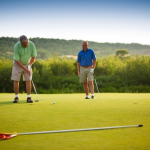8 Exercises to Improve your Scapula Stability and Shoulder Mobility for Golf

Poor posture can have detrimental effects on the golf swing. In our previous blogs, we outlined the ways in which prolonged sitting (e.g. at a desk) can lead to poor posture – specifically upper and lower crossed syndromes.
One of the most common misconceptions about good posture is that it means standing as upright as possible with your shoulder blades (scapula) pinched back and forced together. Not only uncomfortable, that position can also be unhealthy for the function of your shoulder joint.
Q. Why is a healthy shoulder joint important for your golf performance?
A. Research shows that the shoulder generates around 20% of total clubhead speed! (Hume et al., 2005)
In this blog, we will explore what good upper body posture means for your golf and provide you with exercises to help increase your upper back strength and shoulder mobility.
Q. Why is upper back strength important?
A. Because beach workouts just won’t cut it for golf!
By beach workouts we mean training bicep curls and chest press in every session! When your upper back is strong, it becomes much easier and more natural to hold yourself in good posture. When you can transfer and maintain that good posture in your golf swing it becomes much easier to produce increased clubhead speed from the forces generated from the ground up.
Training the back and shoulders for both mobility (shoulders and thoracic spine) and stability (scapula and lumbar spine) allows you to:
Adequately rotate in your backswing and downswing;
Create an explosive stretch-shortening cycle (a.k.a. The X-Factor Stretch);
Generate increased clubhead speed;
Use effective shoulder and arm movements through impact to help control the clubhead (along with the forearms and hands).
We know that a certain amount of external shoulder rotation (turning the upper arm outwards) is needed during the golf swing in both the trail and lead sides. The anatomy and physiology of the body dictates that in order for this external shoulder rotation – and indeed other shoulder movements – to be optimised, the scapula needs to be stabilised by muscles including serratus anterior, rhomboids, levator scapula, and trapezii (Pain & Voight, 2013).
For full article CLICK HERE


